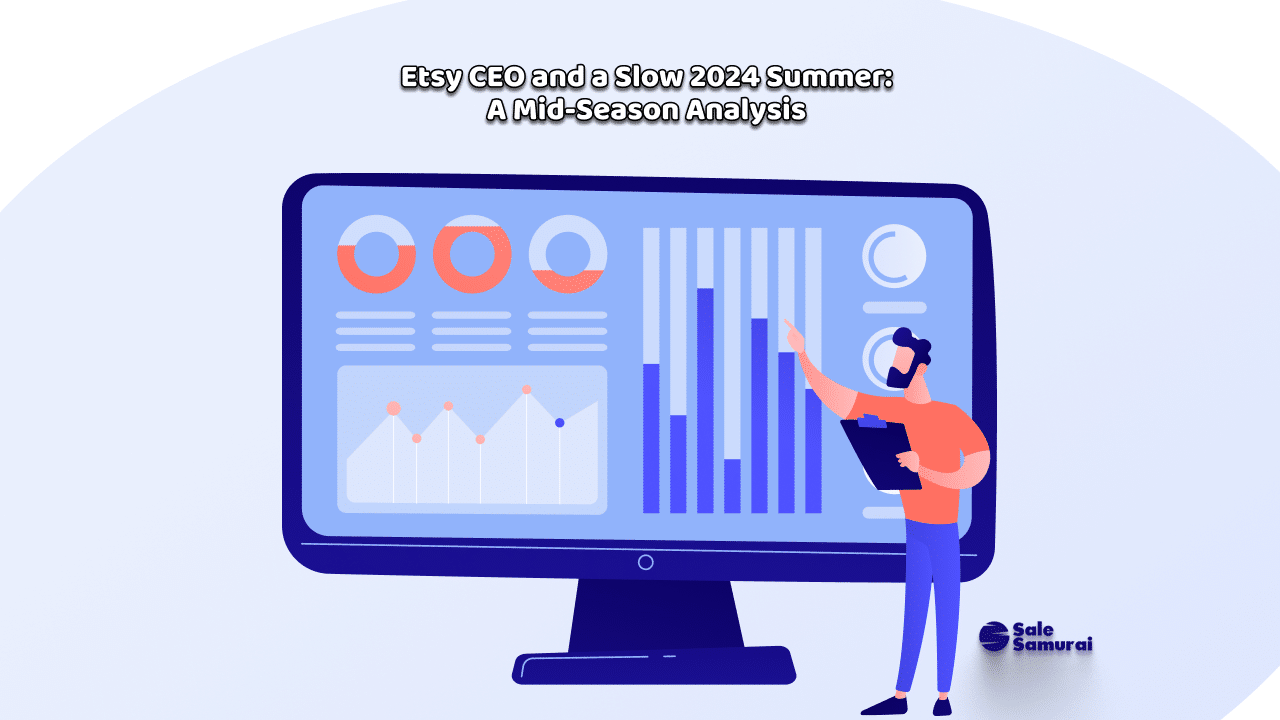
As the summer of 2024 gradually draws to a close, the prediction made by Etsy’s CEO, Josh Silverman, earlier this year is proving to be more accurate than many sellers might have hoped. Silverman had indicated that the summer months could be challenging, with slower-than-usual sales expected across the platform. Now, as we approach the end of the season, it’s clear that this forecast has materialized, with Etsy’s latest quarterly results reflecting the difficulties anticipated earlier in the year.

Etsy CEO Josh Silverman
The CEO’s Prediction: A Look Back
In early 2024, during company meetings and press briefings, Etsy’s CEO Josh Silverman warned sellers about the upcoming summer season. He pointed to several macroeconomic factors that were likely to contribute to a slowdown, including global economic uncertainties, rising inflation, and ongoing geopolitical tensions. Silverman emphasized that while Etsy had remained resilient in previous years, these external factors could significantly dampen consumer spending, particularly on non-essential and luxury items, which make up a substantial portion of Etsy’s marketplace offerings.
Silverman also acknowledged internal challenges within Etsy’s marketplace that could exacerbate the slowdown. The platform’s saturation with similar products made it increasingly difficult for individual sellers to stand out. Additionally, Etsy’s efforts to balance the influx of AI-generated content with the platform’s artisanal roots have led to mixed reactions from both sellers and buyers, further complicating the marketplace dynamics.

A Slow Summer Unfolds: The Numbers Speak
As we progress through the summer, it’s evident that Silverman’s predictions were on point. The latest data from Etsy shows a 2.9% decline in Gross Merchandise Sales (GMS) for the Etsy marketplace in the second quarter of 2024, year-over-year, on a currency-neutral basis. When including results from its other marketplaces, Etsy reported a consolidated GMS decrease of 1.9%. These figures highlight the challenging environment Etsy sellers are currently facing, confirming the anticipated slowdown.
Despite the overall decline in GMS, Silverman expressed a cautious optimism in the company’s quarterly earnings release. He noted:
“We are pleased that second quarter consolidated results included sequential acceleration of Etsy marketplace year-over-year GMS, higher consolidated revenue both year-over-year and sequentially, and strong adjusted EBITDA (Earnings Before Interest, Taxes, Depreciation or Amortization) profitability.” This statement underscores Etsy’s resilience in maintaining profitability even in a tough market, but it also highlights the difficulties specific to the platform’s marketplace performance.
Silverman also mentioned that “Gifting is proving to be a winning theme – driving growth as a key source of differentiation for Etsy,” indicating that while general sales may be down, certain niches within the marketplace are still performing well. This focus on gifting aligns with Etsy’s broader strategy to emphasize unique, handmade products that stand out from mass-produced goods available on other platforms.
Contributing Factors to the Slowdown
Several factors have contributed to the sluggish performance of Etsy’s marketplace during the summer of 2024. The broader economic environment has undoubtedly played a significant role. With consumers facing higher prices on essential goods due to inflation, discretionary spending on items like handmade jewelry, personalized gifts, and home decor—Etsy’s bread and butter—has been squeezed. Many consumers are prioritizing savings or allocating their spending to essential items, which directly impacts platforms like Etsy.
Moreover, the platform’s saturation with similar products has intensified competition among sellers. This oversaturation, particularly in popular categories, has made it difficult for individual sellers to capture buyers’ attention, often leading to price wars and reduced profit margins. Sellers who rely heavily on seasonal trends have found it particularly challenging to compete, with many reporting a noticeable dip in sales compared to previous summers.
In response to these challenges, Etsy has continued to refine its marketplace strategy. The platform has introduced new algorithms designed to prioritize listings that align with Etsy’s original ethos of offering one-of-a-kind, handcrafted products. This move is part of Etsy’s broader effort to distinguish itself from other e-commerce platforms and attract buyers who are looking for unique, high-quality items.
Etsy’s Strategic Adjustments: A Mixed Bag
Etsy’s efforts to navigate this challenging environment have included several strategic adjustments. One significant move has been an increased emphasis on international markets. Recognizing that economic conditions vary across regions, Etsy has focused on expanding its presence in countries where consumer spending remains strong. This international push has provided some relief to sellers who can tap into these markets, although it requires a greater understanding of international consumer preferences and potentially higher shipping costs.
Etsy has also continued to enhance its advertising tools, offering sellers more targeted options to reach potential buyers. By providing advanced analytics and refined targeting capabilities, Etsy aims to help sellers maximize their advertising budgets, even in a slower market. These tools have been well-received, but they require sellers to be more strategic in their marketing efforts, investing time in understanding and utilizing these features effectively.
Silverman acknowledged the complexities of the current market but remained optimistic about Etsy’s long-term prospects. “While this is a challenging environment for our type of goods, we are focused on reigniting Etsy marketplace growth and gaining market share,” he stated. This focus on long-term growth suggests that Etsy is committed to adapting to the current challenges and emerging stronger in the future.
What This Means for Etsy Sellers
As the summer of 2024 nears its end, Etsy sellers are left to navigate a complex landscape. The slower sales have served as a reminder of the importance of diversification and adaptability in business strategies. Here are some key takeaways for Etsy sellers based on the events of this summer:
- Diversification is Key: Sellers who have relied heavily on seasonal products or a narrow range of offerings may need to consider diversifying their product lines. By introducing products that cater to different seasons or broader markets, sellers can mitigate the impact of slow periods. If Silverman’s statement about gifting is correct, think of products that have high giftability.
- Focus on Quality and Uniqueness: With competition fiercer than ever, standing out in a crowded marketplace is crucial. Sellers should focus on the quality and uniqueness of their products, emphasizing the handmade and artisanal aspects that originally made Etsy popular.
- Leverage Etsy’s Tools: Etsy’s advertising tools and analytics are more powerful than ever, but they require a strategic approach. Sellers should invest time in learning how to use these tools effectively to target the right audience and maximize their return on investment.
- Adapt to Economic Realities: Understanding the broader economic context is essential. Sellers should be prepared to adjust their pricing strategies to remain competitive while still ensuring profitability. This might involve offering more affordable options or bundling products to provide greater value.
- Explore International Markets: For sellers who haven’t yet tapped into international markets, now may be the time to do so. Etsy’s push into global markets offers opportunities for sellers to reach new audiences, but it requires careful consideration of shipping costs, pricing, and cultural preferences.

Looking Ahead: The Post-Summer Outlook
As we approach the end of summer, the big question on every seller’s mind is what the future holds for the remainder of 2024. While the summer slowdown has been challenging, there are reasons to be cautiously optimistic. The holiday season, traditionally a strong period for Etsy sellers, is on the horizon. Sellers who take the lessons of this summer to heart and adjust their strategies accordingly may find themselves well-positioned to capitalize on the upcoming busy season.
Etsy’s leadership has acknowledged the difficulties of this summer but remains confident in the platform’s long-term potential. The steps taken to refine the marketplace, enhance seller tools, and expand internationally are all part of a broader strategy to ensure Etsy’s continued growth. Sellers who are willing to adapt and evolve alongside these changes will likely find new opportunities for success in the months ahead.
In conclusion, the summer of 2024 has indeed been slow, as predicted by Etsy’s CEO. However, it has also been a period of learning and adaptation for both the platform and its sellers. By understanding the factors behind the slowdown and taking proactive steps to adjust, Etsy sellers can navigate these challenges and emerge stronger as the year progresses.





